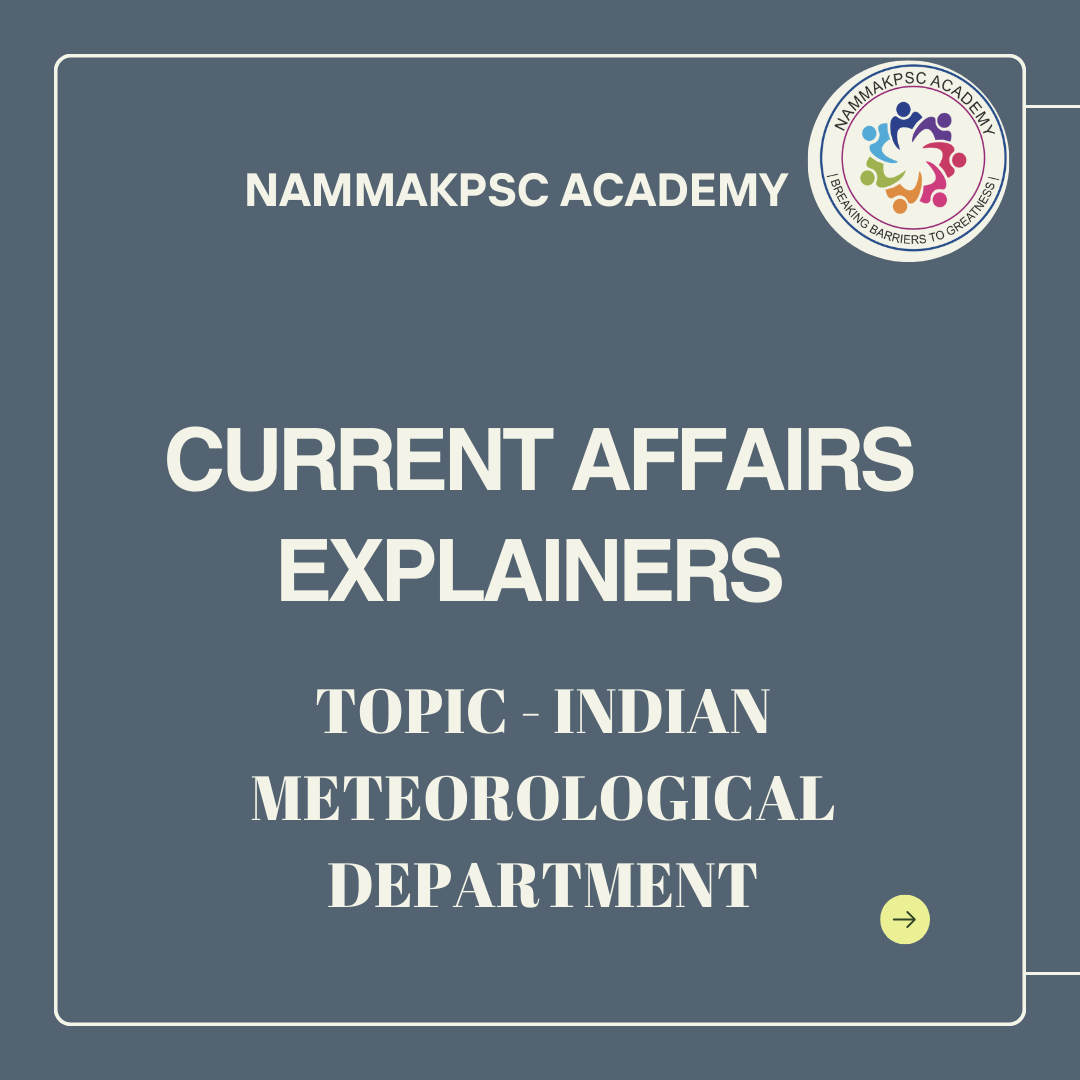Published on: January 19, 2024

INDIAN METEOROLOGICAL DEPARTMENT
INDIAN METEOROLOGICAL DEPARTMENT

CONTEXT : India Meteorological Department (IMD) celebrated its 150th year of establishment and service to the nation
WHAT IS IMD – National meteorological organization of India responsible for providing weather forecasts, warnings, and other meteorological services
WHEN WAS IT ESTABLISHED – 1875
GOVERNING AGENCY – Ministry of Earth Sciences of the Government of India
HISTORY
- Calcutta Observatory in 1785, the Madras Observatory in 1796, and the Colaba Observatory in 1826.
- Subsequent events led to formation of IMD with
- F. Blanford – British meteorologist was first Meteorological Reporter headquarters in Calcutta
- First earthquake observatory in Alipore, Kolkata – 1877
- 1890 assumed the role of Rainfall Registration Authority
FUNCTIONS
- Provide accurate and timely weather forecasts and warnings to support various sectors such as agriculture, aviation, shipping, and disaster management
- It conducts research in meteorology and allied fields, develops technology for weather monitoring, and provides climate-related information
- Processes data received from India’s constellation of satellites, such as Kalpana-1, Megha-Tropiques , and instruments on board the IRS and the INSAT series of satellites
- Plays a pivotal role in monitoring and tracking tropical cyclones in the Indian Ocean
- Monitors long-term climate trends, studies climate variability, and provides climate-related information to different stakeholders
- Involved in seismological activities, monitoring and reporting earthquake data
- Maintains an extensive network of weather stations across the country
SIGNIFICANCE OF IMD
- Warnings are crucial for disaster preparedness, enabling authorities to evacuate vulnerable areas, plan relief operations, and minimize the impact of natural disasters on lives and property.
- Accurate forecasts and warnings to pilots, ship captains, and port authorities, ensuring the safety of air and sea transportation.
- Helps optimize agricultural practices, leading to improved crop yields and resource management in the agricultural sector.
- Advance knowledge of weather conditions aids in managing construction schedules, optimizing energy production, and ensuring the resilience of infrastructure.
- Vital role in emergency response and relief operations during natural disasters.
- Accurate weather information positively influences various economic sectors, including agriculture, tourism, and energy. – Businesses and industries use IMD forecasts to make informed decisions, contributing to economic stability and growth.
- Public Awareness and Education: – IMD engages in public outreach and awareness campaigns, educating the public about weather-related phenomena. – Increased awareness enhances public preparedness and safety during adverse weather conditions.
Initiatives of IMD
- National Monsoon Mission
- The ‘National Monsoon Mission’ (NMM) was launched in 2012 with a goal of developing a state-of-the-art dynamical prediction system for monsoon rainfall on different time scales.
- The goal of the mission is to make a dynamic prediction system using monsoon mission models, on different time scales, like Seasonal (complete Monsoon season), Extended range (up-to 4 weeks), and Short range (up-to 5 days).
- It also seeks to carry out partnerships between Indian and foreign institutes to develop a system for the prediction of extremes and climate applications.
- Mausam App
- The Ministry of Earth Sciences launched the Mausam app to carry out improvement in the dissemination of weather forecasts and warning services based on the latest tools and technologies.
- It has been developed through combined efforts of ICRISAT’s Digital Agriculture & Youth (DAY) team, the Indian Institute of Tropical Meteorology (IITM), Pune, and the India Meteorological Department.
- The app is dedicated to the general public and designed to communicate weather information and forecasts in an easy-to-understand manner.

